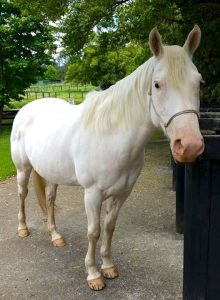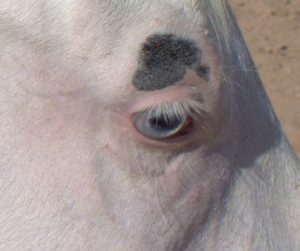

For our first monthly mystery horse we chose Willow, a white paint horse mare. Willow’s owner Hayley gave us the following information about her mare:
I’ve been told she is a maximum sabino ([homozygous] for sabino) who is chestnut based. She is completely white, has one brown eye and one blue eye which I’ve been told is a wall eye. During winter, when her coat grows, she gets chestnut hairs throughout. When she is wet she has small dark dots on her skin and she appears to be getting more as she ages.
She has had two foals, one she had after I bought her. The foal came out a sabino chestnut with a few white socks. The father was a chestnut overo.

We tested Willow for agouti and red/black to find out what colour she is under all that white. The results were e e (homozygous red), A a (heterozygous bay factor). This means she is chestnut, and depending on the stallion could have foals with chestnut, bay/brown or black base coat colours.
To find out why Willow is all white we tested her for a bunch of white pattern genes. The first three were sabino 1, tobiano and W20. We also tested her for frame overo and splashed white 1 (SW1), which can cause white markings and blue in the eyes (blue flecks, a blue eye, or two blue eyes). The results were that Willow is SB1 SB1 (homozygous for sabino 1), and negative for every other white pattern gene we tested, including frame overo.

We were surprised to find out that Willow did not carry either the frame overo or splashed white gene, given that she was described as having a blue eye. However, when Hayley sent us a photo of Willow’s blue eye we realised what was going on: her blue eye is not genetic. In horses blue eyes that have a genetic basis are a vivid icy blue (see bottom illustration). In contrast, Willow’s may be the dark blue that can come from eye injury or age.
We also tested Willow for silver, because this gene has been found in some Australian Paint lines. Willow was negative for silver.
These results show that Hayley was given correct information about her horse’s colour. She is a maximum sabino (also called homozygous sabino), and is chestnut based. While she has one eye that can look a bit blue, she does not in fact have the kind of blue eye that indicates frame overo may be present.